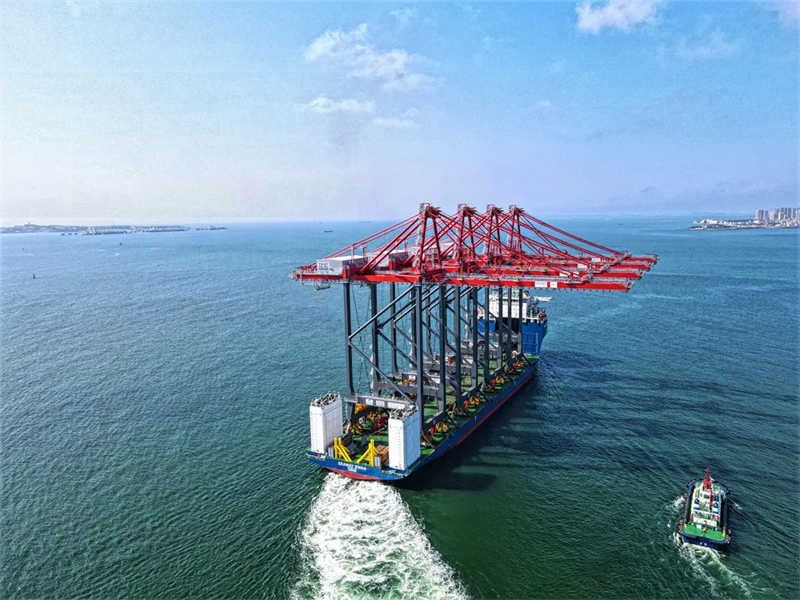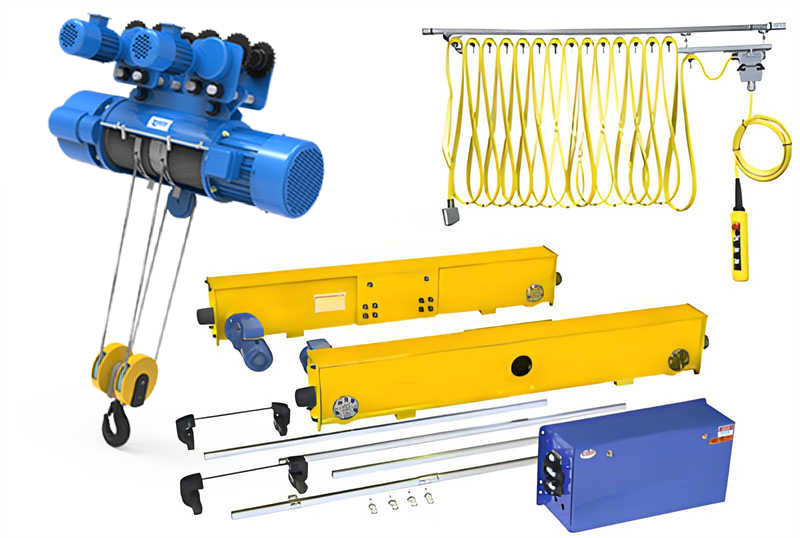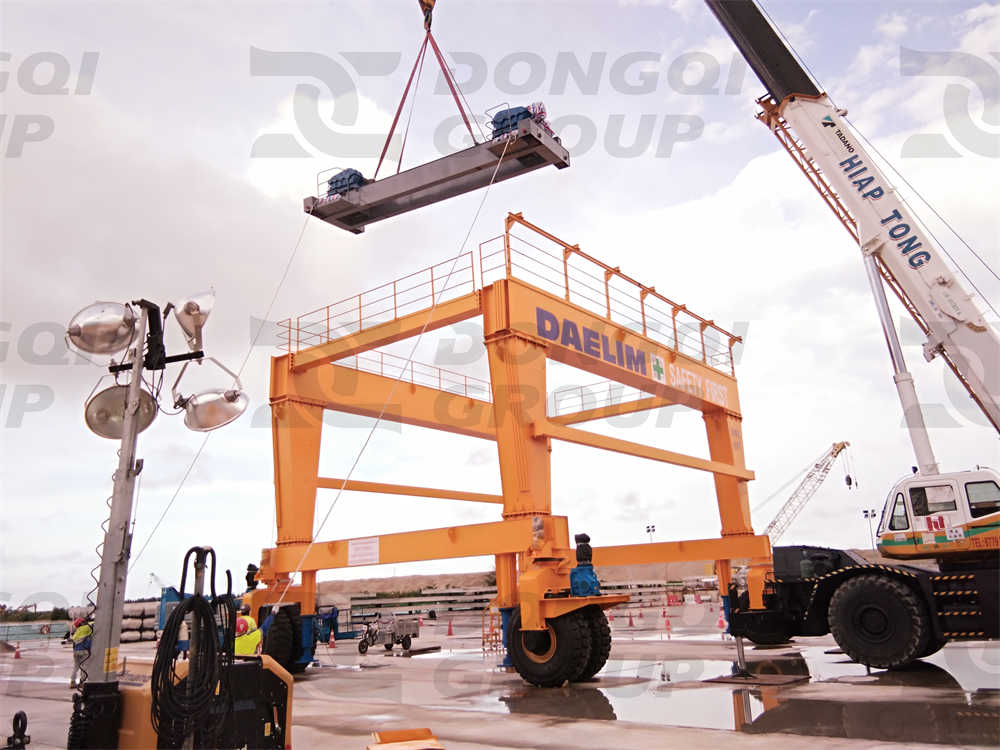27-Dec-2024
Design of Rail-Mounted Container Gantry Crane
Introduction
Definition and Application of Rail-Mounted Container Gantry Crane (RMG)
Rail-Mounted Container Gantry Crane (RMG for short) is one of the special machines for container yards. It moves on the track with running wheels, is driven by mains electricity, and is equipped with 20-foot and 40-foot retractable spreaders (double-box spreaders can also be equipped as needed). It can lift and stack containers within the specified range of the container yard. RMG is gaining more and more favor due to its advantages such as high operating efficiency, high site utilization, high degree of automation, low failure rate, low energy consumption, low operating cost and environmental protection.
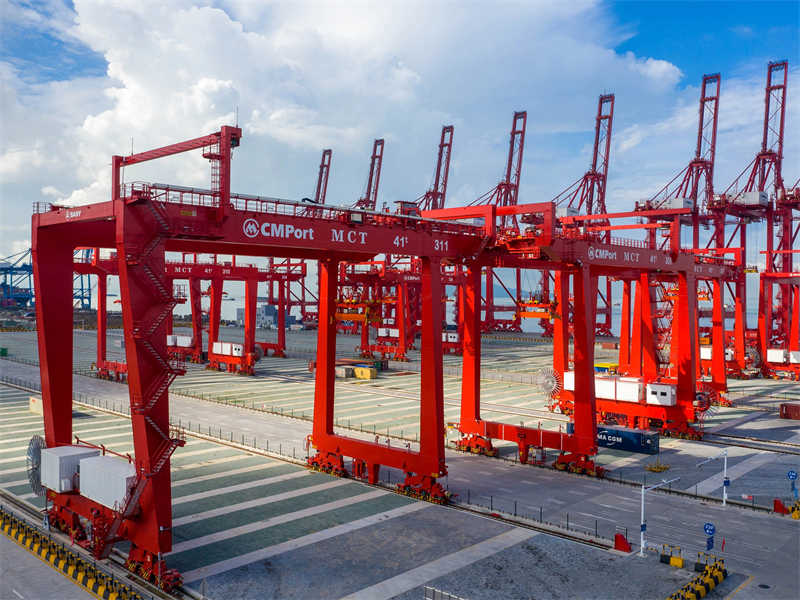
Port transportation occupies an increasingly important position in the world’s economic trade. With the continuous development of global trade, the efficiency of port cargo loading and unloading is directly related to the level of economic benefits. Therefore, the innovation and improvement of port lifting and transportation equipment is particularly important.
Traditional container loading and unloading transportation methods and systems can no longer meet the growing needs of economic trade. Improving the efficiency of container loading and unloading transportation can greatly increase the cargo in and out of the port, thereby improving economic benefits. Therefore, higher requirements are put forward for the design of rail-mounted container gantry cranes.
Design objectives and principles
The design objective is to improve the loading and unloading efficiency of port machinery, and to achieve more efficient and environmentally friendly container loading and unloading operations by designing rail-mounted container gantry cranes with large tonnage, large span and large lifting height. The design principles include:
- Improve loading and unloading efficiency: Improve the operating speed and accuracy of the crane through technological innovation.
- Large tonnage: Design cranes with large lifting capacity to meet the loading and unloading needs of heavy containers.
- Large span: Increase the span of the crane to expand the operating range.
- Large lifting height: Increase the lifting height of the crane to adapt to different types of container yards.
Overall Design
Design Parameters
The design parameters of a rail-mounted container gantry crane (RMG) are the basis of its performance. These parameters determine the crane’s operating capacity and scope of application. The following is an overview of the key design parameters:
- Lifting capacity: The lifting capacity of a crane is one of its most important performance indicators. It determines the maximum weight of a container that the crane can lift. The types of containers commonly used in ports and their weights should be considered during design to ensure that the crane can meet actual operating requirements.
- Lifting height: The lifting height determines the maximum height at which the crane can stack containers. This needs to be determined based on the actual conditions and storage requirements of the container yard to accommodate different types of yards and operating requirements.
- Span: The span refers to the distance between the crane tracks, which determines the crane’s operating range. The width of the yard and the arrangement of containers should be considered during design to ensure that the crane can cover the entire operating area.
- Outreach: The outreach refers to the effective reach of the crane’s cantilever, which determines the crane’s ability to operate at the edge of the yard. For cranes that need to handle containers at the edge of the yard, outreach is an important design parameter.
- Working speed: The working speed includes the lifting speed, trolley running speed, and trolley running speed. These speed parameters determine the operating efficiency of the crane. The actual operating requirements must be taken into consideration during the design to ensure that the crane can complete the lifting and stacking of containers within the specified time.
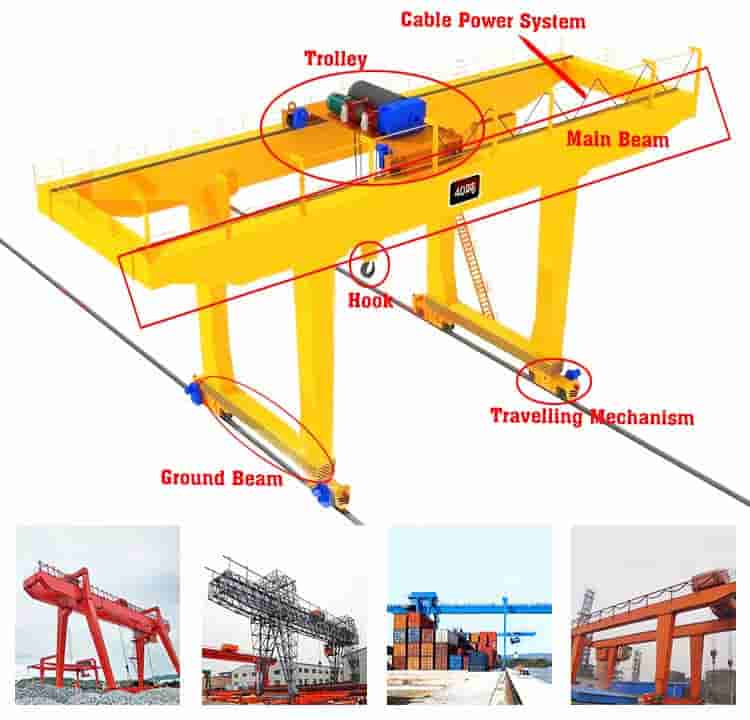
Main beam design
The main beam is an important load-bearing component of the rail-mounted container gantry crane, and its design directly affects the stability and operating efficiency of the crane. The following are the main aspects of the main beam design:
- Basic size design: The length, width and height of the main beam should be determined according to the parameters of the crane’s span, lifting weight and lifting height. The strength, stiffness and stability requirements of the material should be considered during the design to ensure that the main beam can withstand various loads during the operation of the crane.
- Calculation of main beam cross-sectional geometric parameters: The cross-sectional geometric parameters of the main beam include flange width, web thickness, etc. The calculation of these parameters needs to be based on the mechanical properties of the material and the actual working conditions of the crane. Through reasonable cross-sectional design, the bearing capacity and stability of the main beam can be improved.
End beam design
The end beam is a component connecting the main beam and the outrigger. Its design needs to consider the overall structure and stability requirements of the crane. The design of the end beam should meet the following requirements:
- Strength requirements: The end beam needs to be able to withstand various loads during the operation of the crane, including lifting weight, wind load, etc.
- Stiffness requirements: The end beam needs to have a certain stiffness to prevent excessive deformation during the operation of the crane.
- Connection method: The connection method between the end beam and the main beam and the outrigger should be reasonable and reliable to ensure the overall stability of the crane.
Rigid outrigger and flexible outrigger design
The outrigger design of the rail-mounted container gantry crane is the key to its structural stability. The combined use of rigid outriggers and flexible outriggers can balance the stability and flexibility of the crane. The following are the main aspects of outrigger design:
- Rigid outrigger design: The rigid outrigger needs to have sufficient strength and rigidity to withstand various loads during the operation of the crane. Its design should meet the strength and stability requirements, and consider the connection method with the main beam and end beam.
- Flexible outrigger design: The flexible outrigger is connected to the main beam by a hinged connection and has a certain degree of flexibility. Its design needs to consider the dynamic characteristics and stability requirements of the crane to reduce the vibration and impact of the crane during operation.
Lower end beam and upper saddle design
The lower end beam and upper saddle are key components of rail-mounted container gantry cranes. Their design needs to consider the overall structure and operation requirements of the crane. The following are the main aspects of the lower end beam and upper saddle design:
- Lower end beam design: The lower end beam connects the legs and the track and needs to withstand various loads during the operation of the crane. Its design should meet the strength and stiffness requirements and consider the connection method with the track.
- Upper saddle design: The upper saddle is located above the main beam and is used to support the trolley track of the crane. Its design needs to consider the operating stability and operation requirements of the trolley to ensure that the crane can normally lift and stack containers.
Calculation of Crane Stability
As a large and heavy equipment, the stability of the whole machine of the rail-mounted container gantry crane (RMG) is a key factor to ensure safe operation and extend its service life. The stability calculation mainly includes stability verification under no-load and full-load conditions.
1. Calculation of load stability safety factor when the no-load crane is lifting and braking along the track direction
When the crane is lifting and braking along the track direction under no-load conditions, due to the action of inertia force, an overturning moment along the track direction may be generated. In order to ensure the stability of the crane in this case, it is necessary to verify the load stability safety factor.
Steps:
- Calculate inertia force: Calculate the inertia force generated by the crane during lifting and braking according to the mass, acceleration and starting and braking time of the crane.
- Calculate overturning moment: Multiply the inertia force by the vertical distance from the center of gravity of the crane to the track to obtain the overturning moment along the track direction.
- Calculate stability moment: Consider the stability moment generated by the crane’s own weight and the outrigger structure, which is usually calculated by the contact area between the crane outrigger and the ground and the distance from the center of gravity of the crane to the outrigger.
- Calculate the safety factor: Divide the stabilizing moment by the overturning moment to obtain the load stability safety factor along the track direction. This factor should be greater than or equal to the specified standard value to ensure the stability of the crane.
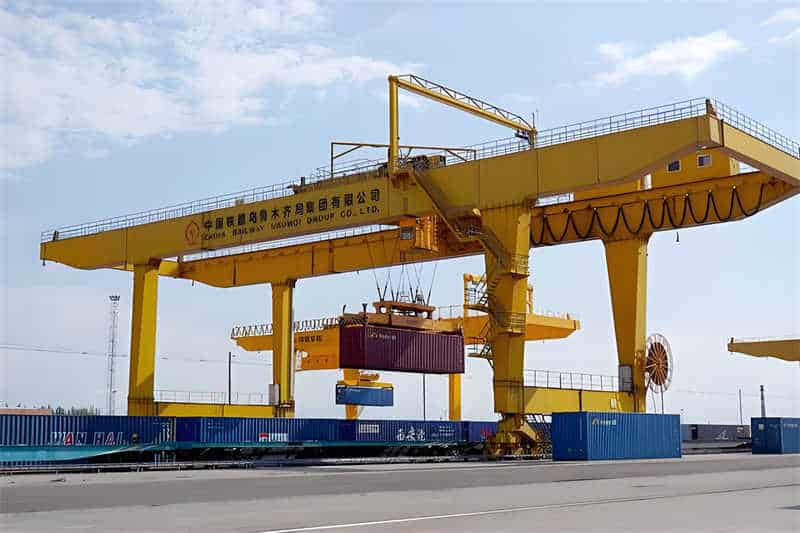
2. Verify the load stability safety factor perpendicular to the trolley track direction when the crane is fully loaded
When the crane is fully loaded, the weight of the container and the weight of the crane itself may cause an overturning moment perpendicular to the track direction when the crane is operating perpendicular to the trolley track direction. In order to ensure the stability of the crane in this case, the load stability safety factor verification is also required.
Steps:
- Calculate the total weight of the container and the crane: Add the total weight of the crane when fully loaded (including the weight of the container and the weight of the crane itself).
- Calculate the overturning moment: Multiply the total weight by the vertical distance from the center of gravity of the crane to the outrigger or track perpendicular to the track direction to obtain the overturning moment perpendicular to the track direction.
- Calculate the stabilizing moment: Consider the contact area between the crane outrigger and the ground and the distance from the center of gravity of the crane to the outrigger, and calculate the stabilizing moment perpendicular to the track direction.
- Calculate the safety factor: Divide the stabilizing moment by the overturning moment to obtain the load stability safety factor perpendicular to the track direction. This factor should also be greater than or equal to the specified standard value.
Notes:
- When performing stability calculations, the force conditions of the crane under various working conditions should be fully considered, including wind loads, dynamic loads and other factors.
- The results of the stability calculation should be combined with the actual test results to ensure the accuracy and reliability of the calculation results.
- During the design process, the crane’s outriggers and tracks should be arranged reasonably to improve the overall stability and load-bearing capacity of the crane.
- Through the above calculations, it can be ensured that the rail-mounted container gantry crane has sufficient stability both under empty and full load conditions, thereby ensuring operational safety and extending service life.
Conclusion and Outlook
Summary of Design Results
The design of this rail-mounted container gantry crane (RMG) has achieved a series of important design results by comprehensively considering the actual needs of port transportation and the efficiency, stability, and environmental protection of crane operations.
First, we determined the key design parameters of the crane, including lifting weight, lifting height, span, outreach, and working speed, which were reasonably set according to the actual operation needs of the port and the performance requirements of the crane.
Secondly, in the design of key components such as the main beam, end beam, rigid outrigger and flexible outrigger, lower end beam and upper saddle, we fully considered the strength, rigidity, stability, and connection methods of the materials to ensure the overall stability and operation efficiency of the crane.
Especially in the outrigger design, we adopted a combination of rigid outriggers and flexible outriggers, which not only ensured the stability of the crane, but also improved its flexibility, enabling it to better adapt to different operating environments and needs.
Analysis of technical innovations and advantages
- Full-speed turning technology: By adopting technologies such as rigid-flexible leg truss steel structure, double-degree-of-freedom trolley, horizontal wheel and electric control system curve speed compensation, the crane can turn at full speed on the curved track, greatly improving the operation efficiency.
- Intelligence and automation: The crane is equipped with intelligent equipment such as storage system, retrieval system, positioning system, and adopts advanced power control system to realize automatic operation and improve operation accuracy and efficiency.
- Environmental protection and energy saving: The crane is driven by electric energy, which reduces noise and exhaust emissions, meets environmental protection requirements, and has low energy consumption, reducing operating costs.
- Modular design: The main components of the crane adopt modular design, which is easy to install, maintain and upgrade, and improves the reliability and service life of the equipment.
Future development trends and improvement directions
With the continuous development of global trade and the increasingly busy port transportation, rail-mounted container gantry cranes will face more challenges and opportunities. In the future, we can make improvements and innovations in the following aspects:
- Improve loading and unloading efficiency: Continue to optimize the structure and control system of the crane, improve the operation speed and accuracy, shorten the loading and unloading time, and increase the port throughput.
- Enhance the level of intelligence: Introduce more advanced intelligent equipment and technologies, such as machine vision, artificial intelligence, etc., to achieve more efficient automated operations and fault warnings.
- Optimize energy utilization: Research more efficient ways of energy utilization, such as the application of renewable energy such as solar energy and wind energy, to reduce energy consumption and operating costs.
- Improve environmental performance: Strengthen the environmental design of cranes, reduce noise and exhaust emissions, and protect the ecological environment.
- Modularization and customization: According to the actual needs of different ports and container yards, provide more modular and customized solutions to meet the diverse needs of customers.
Dongqi Crane, as a leader in the field of lifting machinery, has been committed to providing efficient, environmentally friendly and reliable rail-mounted container gantry crane (RMG) design and manufacturing services to global customers. With our deep industry experience and professional technical strength, we have successfully created a series of RMG products with excellent performance, which have won widespread praise from customers at home and abroad.
Dongqi Crane has a global vision and service network. We actively explore international markets and have established extensive cooperative relationships with customers around the world. No matter where our customers are, we can provide professional RMG design, manufacturing and service. Our products have been successfully used in ports and yards in many countries and regions around the world, creating significant economic and social benefits for customers. If you have RMG design or manufacturing needs, please feel free to contact us and we will be happy to provide you with a satisfactory solution.

